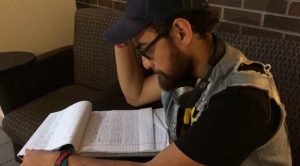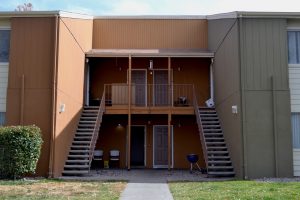By Jazzmin Zama, Katherine Whiting and Sarah Ihlefeld / NM News Port /
Spending your childhood in foster care is no easy feat, neither is aging out of it. According to the National Foster Youth Institute more than 23,000 children will age out of the U.S. foster care system every year upon reaching the age of 18 and 20% of them will become “instantly homeless.”
Now 21 years-old, Central New Mexico Community College student Andrew Salazar understands the struggle and pain that comes with being in foster care and trying to transition into adulthood.

On Oct. 18, 2009, at the age of 13, Salazar and his siblings were taken from their home in Albuquerque’s Northeast Heights when police discovered there was no parent present for over a week. According to Salazar, his mother was under the influence of drugs and had been in and out of an abusive relationship — which led to her abusing her kids, he said.
Fortunately for Salazar, he was placed at a group home in Roswell, New Mexico, for four years where he met his mentor Chuck Dawe.
Dawe coordinates child care at the Assurance Home in Roswell. He is also a retired probation officer for New Mexico’s Children Youth, and Families Department (CYFD).
“He (Andrew) arrived at the Assurance Home the same week that I was hired,” Dawes said. “I was Andrew’s Child Care Worker and he ended up joining the Boy Scout Troop that I was a Scoutmaster in. Through that, Andrew and I developed a very close relationship and it was a privilege for me to be a part of his life.”
Dawe has worked with many foster youth and has seen the struggles foster children go through in their day to day lives. Dawe believes the biggest struggle for foster care youth is their lack of stability, he said.

“When a child is placed in CYFD custody they do not know if they will be reunited with their family. Many times they will have to move to a different city and change schools. They might be placed in a group home or shelter but will not stay there for more than six months,” Dawe said.
Dawe said foster children also have difficulty with creating relationships with the helping adults in the foster care system. Dawe and Salazar created a bond that not many children going through the foster care system receive, he said.
“Chuck Dawe has been like a dad to me. He supported, guided and mentored me when I needed it the most,” Salazar said.
Many of the Assurance Home residents are referred by CYFD. These are often children that are less likely to find foster parents.
According to the Child Welfare Information Gateway, about “six percent of foster care youth live in group homes and eight percent live in institutions.” Most, about 45 percent, live in foster family homes; another 30 percent live with relatives.
Aging out of foster care at age 18 is a particular challenge for foster youth. At that point, they are no longer supported by the foster care system and they are expected to succeed on their own.
Once Salazar turned 18, CYFD was not much help to him during his transition into the working world, he said.
“Without teaching me, I was expected to know how banking works, how to balance my budget, pay rent, and still have money left over for things I need like food and transportation,” Salazar said.
Some places like the Assurance Home have programs in place to help youth with the aging out process.
“At the Assurance Home, we try to teach life skills to our residents. We help residents obtain employment, work with local schools, universities and Job Corps, ” Dawe said. “We also try to assist in things like obtaining a driver’s license, a social security card.”
Salazar was not able to benefit from the help the Assurance Home provides. Salazar lived on his own in Roswell for a year and then came back to Albuquerque after he turned 18.

By Jazzmin Zama/ NM News Port
“I lived by myself in an apartment but I hit a rough patch where I wasn’t fully ready to be an adult,” Salazar said. “I became homeless for about a month until I moved into a group home in Santa Fe.”
Salazar was 19 and lived in Santa Fe until he joined the Transitional Living Program, which is a six to eight month program that provides foster care youth an apartment to live in when they don’t want to live in a group home. Salazar lived in an off-site apartment in Albuquerque. CYFD was supposed to help guide Salazar through the aging out process, but he found himself struggling on his own, he said.
According to Dawe, CYFD has struggled with providing foster care youth the skills they need to be successful once they age out of foster care. CYFD is currently trying to modify this process to provide more support.
“CYFD tries to prepare youth for aging out but each case is different and it is a very difficult process. CYFD has hired Transitional Living Social Workers and this is a big help,” said Dawe.
Jean Taylor, manager of the foster care adoption bureau at CYFD said there are newer programs enabled to help foster youth with emancipation.
“Transitional support systems have helped those aging out of foster care,” Taylor said. “At the age of 16 and a half to 18 we start helping them with finding safe and stable housing, health and mental health services, help with medicaid and linking them with significant adult connections.”
Youth Services Bureau Chief, Maya McKnight said CYFD social workers help teens make plans and learn life skills.They provide quarterly events for youth and encourage them to go to a life skills academy through their foster care homes and via New Day, an organization that helps at-risk youth.
Foster children that are 14 and up qualify for transition support services, as well as those that age out at 18 or over, and youth that were adopted at 15 or older.
Nationally, some 250,000 kids enter the foster system every year.
In New Mexico, according to AdoptUSKids, there are 2,316 children in foster care; and “705 of these children are waiting for adoptive families.”
According to New Mexico’s Children 2017 Fact Sheet, the most recent data on the number of young adults aging out of foster care in New Mexico is from 2015 when 75 exited foster care as emancipated adults. “We know they will age out of foster care and want them to have solid plans on housing,” said McKnight. “We also want them to have support with family.”
CYFD also distributes federal funds to foster youth who age out. The “IL Stipend” — for independent living — is a monthly check of about $618 paid directly to the young adult as long as they provide monthly proof that they go to school or work
“The funds we offer can provide money for rent, household items, utilities, furniture, anything that can help them for independence. We also give youth up to $1,500 total before their 21st birthday,” McKnight said.
She added, “If they go to college we pay up to $5,000 per year for school use and they have access to the tuition and fee waiver if they age out in New Mexico.”
Recipients are taught how to use the money for important things and not illegal activity, McKnight said.
“If they choose to work with us we keep in contact with them, and meet out in the community or in our offices. It varies,” McKnight said. “Sometimes youth leave or they age out and don’t want to come back at all.”
Though Salazar had difficulties with aging out of foster care he is finally able to provide for himself and manage his money, he said. Salazar stays in touch with those who helped him through difficult times including his high school graduation, he said.
“I look at Andrew as family and I think that he feels the same too,” said Dawe.
For more follow Jazzy Zama, Katherine Whiting, and Sarah Ihlefeld on Twitter